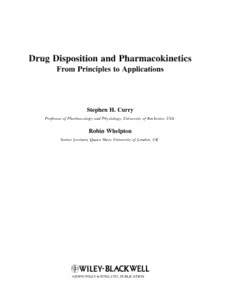
Drug Disposition and Pharmacokinetics From Principles to Applications PDF
Preview Drug Disposition and Pharmacokinetics From Principles to Applications
Drug Disposition and Pharmacokinetics From Principles to Applications Stephen H. Curry ProfessorofPharmacologyand Physiology,University ofRochester, USA Robin Whelpton SeniorLecturer, Queen Mary Universityof London, UK Drug Disposition and Pharmacokinetics From Principles to Applications Drug Disposition and Pharmacokinetics From Principles to Applications Stephen H. Curry ProfessorofPharmacologyand Physiology,University ofRochester, USA Robin Whelpton SeniorLecturer, Queen Mary Universityof London, UK Thiseditionfirstpublished2011 (cid:1)2011JohnWiley&Sons,Ltd. Registeredoffice JohnWiley&SonsLtd,TheAtrium,SouthernGate,Chichester,WestSussex,PO198SQ,UnitedKingdom Fordetailsofourglobaleditorialoffices,forcustomerservicesandforinformationabouthowtoapplyforpermissiontoreuse the copyright material in this book please see our website at www.wiley.com. TherightoftheauthortobeidentifiedastheauthorofthisworkhasbeenassertedinaccordancewiththeCopyright,Designs andPatentsAct1988. Allrightsreserved.Nopartofthispublicationmaybereproduced,storedinaretrievalsystem,ortransmitted,inanyformorbyany means,electronic,mechanical,photocopying,recordingorotherwise,exceptaspermittedbytheUKCopyright,DesignsandPatents Act1988,withoutthepriorpermissionofthepublisher. Wileyalsopublishesitsbooksinavarietyofelectronicformats. Somecontentthatappearsinprintmaynotbeavailable inelectronicbooks. Designationsusedbycompaniestodistinguishtheirproductsareoftenclaimedastrademarks.Allbrandnamesandproductnames usedinthisbookaretradenames,servicemarks,trademarksorregisteredtrademarksoftheirrespectiveowners.Thepublisher isnotassociatedwithanyproductorvendormentionedinthisbook.Thispublicationisdesignedtoprovideaccurateandauthoritative informationinregardtothesubjectmattercovered.Itissoldontheunderstandingthatthepublisherisnotengagedin renderingprofessionalservices.Ifprofessionaladviceorotherexpertassistanceisrequired,theservicesofacompetent professionalshouldbesought. LibraryofCongressCataloging-in-PublicationData Curry,StephenH. Drugdispositionandpharmacokinetics:fromprinciplestoapplications/ StephenH.CurryandRobinWhelpton. p.;cm. Includesbibliographicalreferencesandindex. ISBN978-0-470-68446-7(cloth) 1. Pharmacokinetics.2. Biopharmaceutics.3. Drugs–Metabolism. I. Whelpton,Robin.II.Title. [DNLM:1. Pharmacokinetics.2. Biopharmaceutics.3. Pharmaceutical Preparations–metabolism. QV38C976da2010] RM301.5.C8632010 615’.7–dc22 2010003126 AcataloguerecordforthisbookisavailablefromtheBritishLibrary. PrintISBN:978-0-470-684467 ePDFISBN 9780470665220 oBookISBN:9780470665190 Setin10/12pt,Times-Roman byThomsonDigital,Noida,India Contents Preface xvii AbouttheAuthors xxi 1 ChemicalIntroduction:Sources,ClassificationandChemicalPropertiesofDrugs 1 1.1 Introduction 1 1.1.1 Sourceofdrugs 2 1.2 Drugnomenclatureandclassification 3 1.3 Propertiesofmolecules 3 1.3.1 Decompositionofdrugs 7 1.3.1.1 Hydrolysis 7 1.3.1.2 Oxidation 9 1.3.1.3 Photodecomposition 9 1.3.1.4 Racemization 9 1.4 Physicochemicalinteractionsbetweendrugsandotherchemicals 9 1.4.1 Chemicalbondingandinteractionsbetweenmolecules 10 1.4.2 Solubility 11 1.5 Lawofmassaction 11 1.5.1 Reversiblereactionsandequilibriumconstants 11 1.5.1.1 Sequentialreactions 12 1.5.2 Reactionorderandmolecularity 12 1.5.3 Decaycurvesandhalf-lives 13 1.5.3.1 First-orderdecay 13 1.5.3.2 Zero-orderdecay 14 1.5.3.3 Second-orderdecay 15 1.6 Ionization 16 1.6.1 Henderson–Hasselbalchequation 18 1.7 Partitioncoefficients 18 1.7.1 Effectofionizationonpartitioning 19 1.8 Stereochemistry 20 1.8.1 Cis-transisomerism 20 1.8.2 Opticalisomerism 21 1.8.2.1 Absoluteconfiguration 21 1.8.3 Importanceofstereochemistryinpharmacology 21 Furtherreadingandreferences 22 2 DrugAdministrationandDistribution 23 2.1 Introduction 23 2.2 Drugtransferacrossbiologicalmembranes 24 2.2.1 Passivediffusion 24 2.2.1.1 pH-partitionhypothesis 25 2.3 Drugadministration 26 vi Contents 2.3.1 Oraladministration 26 2.3.1.1 Presystemicmetabolism 27 2.3.1.2 P-Glycoprotein 29 2.3.1.3 Gastrointestinalmotilityandsplanchnicbloodflow 29 2.3.1.4 Foodanddrugs 30 2.3.2 Sublingualadministration 31 2.3.3 Rectaladministration 31 2.3.4 Intravenousandintra-arterialinjections 31 2.3.5 Intramuscularandsubcutaneousinjections 31 2.3.6 Transdermalapplication 32 2.3.7 Insufflation 32 2.3.8 Inhalation 32 2.3.9 Otherroutesofadministration 32 2.4 Drugdistribution 33 2.4.1 Extentofdistribution 33 2.4.1.1 Apparentvolumeofdistribution 33 2.4.2 Mechanismsofsequestration 34 2.4.2.1 pHdifferences 35 2.4.2.2 Bindingtomacromolecules 35 2.4.2.3 Dissolutioninlipids 35 2.4.2.4 Activetransport 35 2.4.2.5 Specialprocesses 35 2.4.3 Kineticsofdistribution 35 2.4.3.1 Tissuedistributionofthiopental 37 2.4.3.2 Tissuedistributionofguanethidine 38 2.4.4 Tissuedistribution:moremodernapproaches 39 2.4.4.1 Microdialysis 39 2.4.4.2 Autoradiography 40 2.4.4.3 Positronemissiontomography(PET) 41 2.5 Plasmaproteinbinding 42 2.5.1 Assessingproteinbinding 44 2.5.1.1 Equilibriumdialysis 45 2.5.1.2 Ultrafiltration 46 2.5.2 Molecularaspectsofproteinbinding 46 2.5.2.1 Microcalorimetry 46 2.5.2.2 Fluorescencespectroscopy 47 2.5.2.3 Circulardichroism(CD) 48 2.5.2.4 Electronparamagneticresonancespectroscopy(EPR) 49 2.5.2.5 Commentary 49 2.5.3 Pharmacologicalimportanceofbindingtoplasmaproteins 49 2.6 Summary 50 Referencesandfurtherreading 50 3 DrugElimination 53 3.1 Introduction 53 3.2 Metabolism 53 3.2.1 Phase1metabolism 54 3.2.1.1 CytochromeP450superfamily 55 3.2.1.2 Otheroxidases 56 3.2.1.3 Hydrolysis 57 3.2.1.4 Reductions 58 3.2.2 Examplesofphase1oxidation 59 Contents vii 3.2.2.1 Oxidationofalcohols 59 3.2.2.2 Aliphaticandaromatichydroxylations 59 3.2.2.3 Oxidativedesalkylation 59 3.2.2.4 N-andS-oxidation 59 3.2.2.5 Oxidativedeamination 61 3.2.2.6 Desulfuration 61 3.2.2.7 Combinationofreactions 61 3.2.3 Miscellaneousreactions 62 3.2.4 Phase2metabolism 62 3.2.4.1 D-Glucuronidation 62 3.2.4.2 Sulfation 63 3.2.4.3 N-Acetylation 64 3.2.4.4 Methylation 64 3.2.4.5 Glycineconjugates 65 3.2.4.6 Conjugationwithglutathione 65 3.2.5 Kineticsofmetabolism 65 3.3 Excretion 67 3.3.1 Urine 67 3.3.1.1 Glomerularfiltration 68 3.3.1.2 Activetubularsecretion 68 3.3.1.3 Passivediffusion 68 3.3.1.4 Renalclearance 69 3.3.1.5 EffectofurinepHandflowrate 70 3.3.2 Biliaryexcretion 70 3.3.3 Expiredair 71 3.3.4 Saliva 71 3.3.5 Stomachandintestine 73 3.3.6 Breastmilk 73 3.3.7 Otherroutesofexcretion 74 3.3.7.1 Sweat 74 3.3.7.2 Hairandnails 74 3.3.7.3 Genitalsecretions 75 3.3.8 Cyclingprocesses 75 3.3.8.1 Enterohepaticcycling 75 3.3.8.2 Significanceofcyclicprocesses 76 Referencesandfurtherreading 76 4 ElementaryPharmacokinetics 77 4.1 Introduction 77 4.2 Single-compartmentmodels 78 4.2.1 Systemicclearance 79 4.2.2 Whydrugshavedifferenteliminationhalf-lives 80 4.2.3 Intravenousadministration 81 4.2.3.1 Half-life 81 4.2.3.2 Areaunderthecurve 83 4.2.4 Absorption 84 4.2.4.1 Areaunderthecurve 85 4.2.4.2 Specialcases:k < landk ¼l 86 a a 4.2.4.3 Specialcase:lagtime 87 4.2.5 Infusions 87 4.2.5.1 Zero-orderinput 88 4.2.5.2 Loadingdose 89 viii Contents 4.2.6 Multipledoses 90 4.3 Non-linearkinetics 92 4.3.1 Phenytoin 93 4.3.2 Ethanol 94 4.4 Relationshipbetweendose,onsetanddurationofeffect 95 4.5 Limitationsofsingle-compartmentmodels 96 4.6 Summary 97 Referencesandfurtherreading 97 5 MoreComplexandModelIndependentPharmacokineticModels 99 5.1 Introduction 99 5.2 Multiplecompartmentmodels 99 5.2.1 Intravenousinjections 99 5.2.1.1 Concentrationsintheperipheralcompartment 101 5.2.1.2 Microconstants 102 5.2.1.3 Apparentvolumesofdistribution 103 5.2.1.4 Clearance 104 5.2.2 Absorption 105 5.2.3 Infusions 105 5.2.4 Multipleoraldosing 106 5.2.5 Conceptofcompartments 107 5.2.6 Relationshipbetweendoseanddurationofeffect 108 5.3 Curvefittingandchoiceofmostappropriatemodel 110 5.3.1 Graphicalsolution:methodofresiduals 110 5.3.2 Iterativecurve-fitting 111 5.3.2.1 Weighted-regression 111 5.3.2.2 Choiceofmodel 112 5.3.3 Qualityofthedata 112 5.4 Modelindependentapproaches 113 5.4.1 CalculationofV andclearance 113 Area 5.4.2 Statisticalmomenttheory 114 5.4.2.1 EstimatingAUMC 115 5.4.2.2 ExampleofapplicationofSMT 116 5.5 Populationpharmacokinetics 117 5.6 Summary 118 ReferencesandFurtherReading 118 6 KineticsofMetabolismandExcretion 121 6.1 Introduction 121 6.2 Metabolitekinetics 121 6.2.1 Basicconcepts 121 6.2.2 Fractionofmetaboliteformed 124 6.2.3 Morecomplexsituations 125 6.2.4 Activemetabolites 126 6.2.5 Effectofpresystemicmetabolism 127 6.2.6 Interconversionofdrugandmetabolite 128 6.3 Renalexcretion 129 6.3.1 Kineticsofurinaryexcretion 129 6.3.1.1 Renalclearance 130 6.3.1.2 Effectofurineflowrate 131 6.3.2 Specificdrugexamples 132
